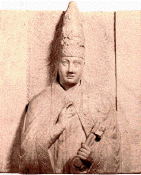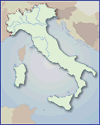
Pope Boniface VIII (1294-1303)
The Political Papacy and its Critics
Pope Boniface VIII (1294-1303) |
The Political Papacy and its Critics |

Charles
of Anjou |
Pope Gregory IX 1227-1241 Pope Innocent IV 1243-1254 First Council of Lyon 1245 (Link to Map) Emperor Frederick II 1212-1250 Interregnum 1250-1273 Pope Urban IV (Jacques Pantaléon) 1261-1264 Crusade against Manfred (Battle of Benevento 1266) Pope Clement IV (Gui Faucoi le Gros )1265-1268 Pope Gregory X 1271-1276 |
|
Sicilian Vespers 1282 King Peter III of Aragon Thirteenth-Century Iberian Peninsula
|
Angevin (French) Aragonese (Spanish) |
Enna, Sicily Hohenstaufen Castle |
Pope Martin IV (Simon de Brion) 1281-1285 King Philip III of France leads a crusade with Pope Martin IV's blessing against Peter III of Aragon 1285 Pope Honorius IV 1285-1287 Pope Nicholas IV 1288-1292 Peter Marrone = Pope Celestine V (1294) |
Triumph of Death (ca. 1450) Anonymous, Palermo Click on the Picture for the Entire Fresco
|
|
|
Benedict Gaetani = Pope Boniface VIII (1294-1303) |
Boniface launches crusade against Cardinals James and Peter Colonna 1297 Taxing the French Clergy Clericis laicos 1296 First Jubilee Year 1300 |
| King
Philip IV, the Fair, of France 1285-1314 William of Nogaret, jurist and advisor to Philip IV Anagni September 7, 1303 |
Fourteenth-Century Italian City States |
| Avignonese Papacy = "Babylonian Captivity" (1305-1378) | |
|
Entrance to the Medieval Palace Ubi papa ibi Roma |
Benedict XI 1303-1304 Clement V 1305-1314 John XXII 1316-1334 Benedict XII 1334-1342 Clement VI 1342-1352 Innocent VI 1352-1362 Urban V 1362-1370 Gregory XI 1371-1378
|
Criticisms of the Papacy and the Clergy
|
Dante Alighieri, Commedia Inferno, Canto 19 Dante Alighieri 1265-1321 |
| Geoffrey
Chaucer(ca. 1340-1400) Canterbury Tales |
Franceso Petrarch (1304-1374), Letter to Friend Describing Avignon |
| Giovanni
Boccaccio (ca. 1313-1375) Decameron (1352)
|
Papal Throne, Santa Maria in Trastevere, Rome |
|
Urban VI (1378-1389) Boniface IX (1389-1404) Innocent VII (1404-1406) Gregory XII (1406-1415)
|
The Great Schism (1378-1415) Avignon Line Clement VII (1378-1394) Benedict XIII (1394-1423)
|
Council of Pisa (1409) created a third pope Alexander V (1409-1410) John XXIII (1410-1415)
|
|
The burning of John Hus at the Council of Constance, Chronik der Konstance Koncils, Rosgartenmuseum, Konstanz John Hus (ca. 1370-1415) Bohemia John Wyclif (1330-1384) Eucharist: Laymen could receive wine Clerical exercise of secular power Emperor Sigismund Safe Conduct Council deposes Popes John XXIII, Benedict XIII, and Gregory XII Haec Sancta Council is superior to the pope. Frequens Councils must be held every 10 years (1st 5 years, 2nd 7 years, then every 10 years) |
Council of Constance (1415)
Pope Martin V 1417-1431 Councils of Pavia, Siena (1423-1424) Basel (Conciliar) (1431-1449) Reunion of Latin and Greek Churches Ferrara and Florence (Papal) (1438-1447) Council of Basel elects Felix V (Antipope) 1438 Triumph of Papal Monarchy |